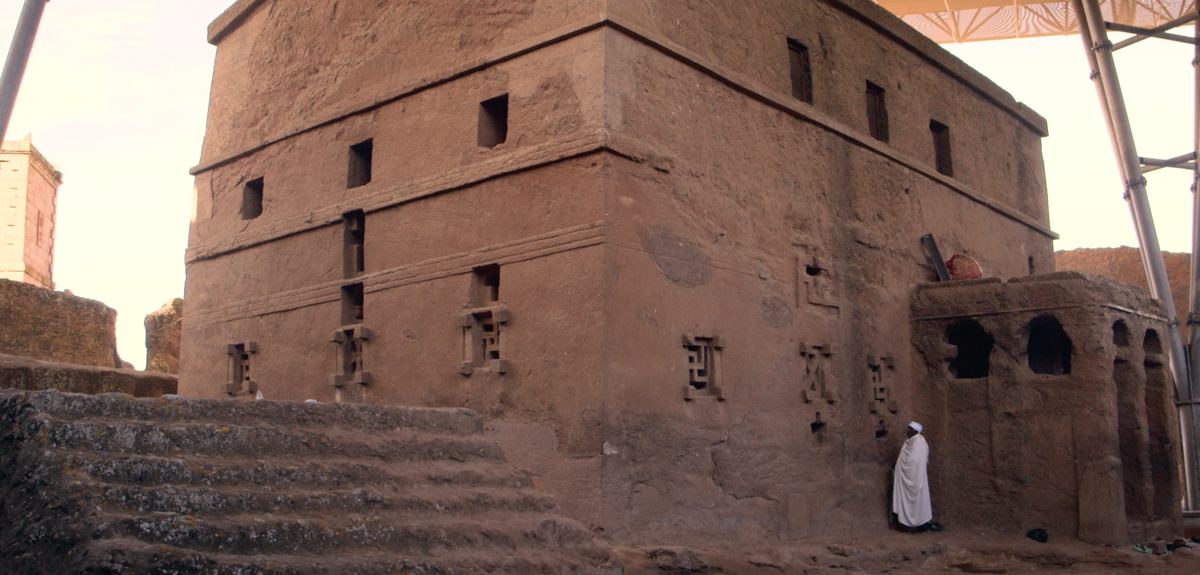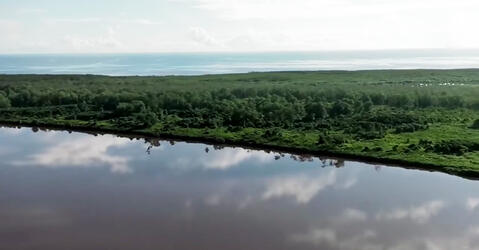You are here
Lalibela, often called the Jerusalem of Ethiopia. An incredibly complex site, filled with trenches and galleries, these majestic rooms draw the faithful from all over the country. Carved from volcanic rock and covering the highland plateaus of Ethiopia, stand eleven monumental churches.
According to local history, King Lalibela ordered and supervised 24 years of hard work to create the site that we see today. It became, toward the end of the 12th century, the center of his Christian Kingdom.rr
Historian Marie-Laure Derat and her team have studied this vast complex for over ten years. Their research points to an even richer story that has yet to be told…
Marie Laure
We found a lot of anomalies, things that wouldn’t be logical. Here’s an example typical for the site: we have stairs carved out here, and obviously they aren’t meant to lead into a deep hole. So for these stairs to make sense, we have to assume there was originally a floor. Not only that, a full courtyard extending outward that made the entire space accessible, from one side to the other, unlike how we see it today.
Confirming these successive steps in excavation is among the biggest priorities to understand the history of Lalibela over time. But the simple fact that the site was created by excavation and not by construction poses many challenges to archaeologists who wish to trace its past…
Romain
Seeing as they carved these churches, this site is anti-archaoligical. In other words it doesn’t conserve the stratigraphy, because the further they dug, the more they erased the traces of previous work…
These traces were erased as the churches were carved anew. But excavation created large volumes of debris… that accumulated during each phase until forming hills scattered across the site. Hills that can be searched for clues.
Romain
We can see two main sources of shavings in this large pile. The substrate has a slope to it, and the debris created by the first excavation of the church followed this slope. After they stopped adding debris, a topsoil formed above it. Vegetation was able to grow, so over time it left a layer of organic material.
When we dug here, we found this layer of soil, followed by another round of debris, which indicates there must have been a second phase of excavation of these churches. So when we arrived on site, our phase hypothesis struck a chord with what we found. If there were two phases of debris, that could correspond with two distinct phases of digging.
New Transition:
The hills don’t just contain clues to the excavation phases of these monuments… they have also hidden, for hundreds of years, the ruins of an even older monument that seems just as noteworthy. The big blocks emerging on the side of the embankment date back to two centuries before the reign of King Lalibela and the founding of his churches. A history of the site that remains to be written…
Clues confirming the different excavation phases of Lalibela’s monuments aren’t the only source of valuable information in this pile of rubble… the team is also interested in these big stone blocks. These remnants of a massive wall date back two centuries before the reign of King Lalibela and the founding of his churches.
Marie Laure
Normally when walls are made with blocks this big, they’re building really high. If not, there’s no point in using these for only two or three levels. So in all likelihood it was really really tall. And with everything we’re learning, if the blocks are this big, it’s probable that they were cut on the spot before being placed here.
So we will probably not find an untouched layer of bedrock under this heap of rubble - but what we are likely to find is that the negative space left after removing these blocs will have served some purpose for the people who lived here...
Donc potentiellement on n’aura pas accès à la roche mère, au bedrock, sous le tas de déblais, mais plutôt à déjà des aménagements du rocher lié au débitage des blocs et puis sans doute à des aménagements et de l’occupation.
Marie-Laure and her team’s research is part of a Franco-Ethiopian cooperation, attempting not only to understand the long history of Lalibela, but equally to protect this UNESCO World Heritage site. One of the central projects of this partnership is to create a digital copy of the site. In order to produce this 3D model of Lalibela in all its complexity, heritage specialists visit each gallery and room to photograph every nook and cranny.
The spatial geometry of each location is also recorded by laser scanner.
The high places are photographed by drone.
All of this data enables the creation of a 3D model of Lalibela, inside and out…
Loic
The idea is to already have a complete 3D recording of the site. It’s really important because the monuments are evolving over time and will continue to do so despite what conservation efforts are put in place.
Ambient: Loic on his computer
We can see the ghosts of people who walked through while we were scanning. It’s not a big deal – afterward it’s just a cleanup job in the model. On the other hand, from here, we can work on the sections – slice by slice as we move through the building.
Loic
So this data is what we use to continue working on the project even when we aren’t on site, and enables us to see things we’d struggle to with the available light in the church - like some paintings. On top of that, we gain a truly global view of the entire site.
This research will continue over the coming years, in parallel with efforts deployed to assure the conservation of this sacred and fragile site. A new chapter added to the long and complex story of Lalibela, as it continues to span the ages.
Lalibela: a city dug in a rock
Eleven churches carved from a rock, centuries of history and a mystery that remains. An ambitious research programme tries to unveil the complex past of Lalibela, the largest christian site in Africa, located in Ethiopia. The ongoing research will also help preserve this fragile heritage for future generations.
Laboratoire Orient et Méditerranée
CNRS / Université Paris-Sorbonne / Université Panthéon-Sorbonne
École Pratique des Hautes Études / Collège de France
Romain Mensan
TRACES
CNRS / Université de Toulouse Jean Jaurès
Ministère de la Culture / Inrap
Loïc Espinasse
Archéovision
CNRS / Université de Bordeaux
Université de Bordeaux Montaigne





